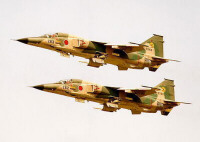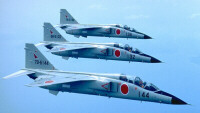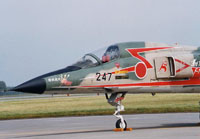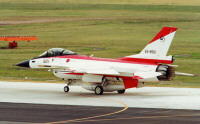Mitsubishi F-1
Role: ground attack, maritime strike, fighter
Production: Mitsubishi Heavy Industries
Variants: F-1
Operators: Japan (1977-2006)
Mitsubishi F-1 is a single-seat supersonic fighter aircraft developed to serve the Japan Air Self-Defense Force (JASDF) in the anti-shipping and ground attack roles. The F-1 was derived from the T-2 supersonic two-seat advanced jet trainer that first flew on 20 July 1971. In 1973 the program designated FST-2 Kai for the single-seat attack version was launched and two T-2 aircraft were converted to serve as prototypes. The first FST-2 prototype made its first flight on 3 June 1975.
The rear cockpit was converted to an avionics bay, replacing the canopy with an access hatch. The fire control system consisted of the J/ASQ-1 computer and the Japanese version of the AN/AWG-12 radar set with fire control radar and ground mapping mode, and J/AWA-1 control system for the ASM-1 anti-shipping missile. Other avionics added included the J/APR-3 radar warning system (RHAWS) for electronic self-defence. The airframe was fitted an internally mounted M61A1 Vulcan 20mm gun with 750 rounds of ammunition. The airframe was strengthened for weapon carriage, and two additional under-wing hardpoints were added, giving the aircraft four under-wing stations in addition to the wing-tip rails and fuselage centreline pylon.
Following 1975 budget approval for an initial 18 aircraft, the Mitsubishi F-1 entered production in 1976. Upon completion of flight and acceptance testing of the FST-2 prototypes, the attack fighter was designated F-1 by the JASDF. The first production F-1 was rolled out on February 1977 and made its first flight on 16 June 1977. The F-1 was the first combat turbojet powered aircraft developed by Japan since World War II. The first F-1 was delivered on 16 September 1977 and by April 1978 the F-1 entered operational service, equipping the 3rd Squadron of the 3rd Air Wing at Misawa Air Base. From June 1979 to the end of February 1980, the 8th Squadron of the 3rd Air Wing also transitioned to the F-1. The third and final unit to fly the F-1 was the 6th Squadron of the 8th Air Wing at Tsuiki Air Base, becoming operational on 1 March 1981. A total of 77 aircraft were built, with the final delivery taking place on 9 March 1987.
For the primary role of anti-shipping the F-1 was armed with the 50km range Type 80 ASM-1 (air-to-ship missile 1), later replaced by the Type 93 ASM-2 derivative. For ground attack the F-1 could be armed with unguided Mk.82 or Mk.117 bombs and 70mm or 125mm rockets, as well as GCS-1, a Mk.82 or Mk.117 fitted with infrared guidance kit. The F-1 had an air-to-air capability using the M61A1 20mm gun and AIM-9 heat seeking missile or its Japanese equivalent for self-defence and to fulfil its secondary role of air defence.
Like the T-2, the F-1 was powered by two afterburning TF40-IHI-801A (license-built version of the Adour Mk.102) turbofan engines. While the F-1 was only somewhat heavier than the T-2 in clean configuration, carrying weapons and/or auxiliary fuel tanks the F-1 was considered underpowered, however budget constraints prohibited retrofitting uprated or different engines. The limited air-to-air capabilities, lack of defensive jamming and counter-measures, and a design that was better suited for low-level attack profiles than air combat manoeuvring, meant the F-1 was soon considered to be obsolete.
The FS-X project that would deliver its replacement during the 1990s was much delayed, but due to budget restrictions the F-1 fleet still had sufficient airframe flying hours to extend its service. When FS-X materialized as the F-2 based on the F-16 further development and structural problems found on the F-2 in 1997, meant further postponement of the F-1's replacement and new platform for the air-launched anti-shipping missile. To relief the F-1 fleet, 8th Squadron at Misawa Air Base converted from the F-1 to F-4EJ Kai aircraft formerly used by 306 Squadron of Komatsu Air Base. Finally in October 2000, 3rd squadron at Misawa started to convert to the new F-2, the transition from the F-1 to the F-2 was completed by the end of February 2001, ending F-1 operations at Misawa. In 2003, the last overhaul and repair of 14 remaining aircraft was carried out. The third and last F-1 unit, 6th Squadron at Tsuiki Air Base continued operating seven F-1 while its new F-2 started to arrive. 6th Squadron retired its final six F-1 aircraft on 9 March 2006.

Mitsubishi F-1

T-2 advanced trainer

F-1 single cockpit and avionics bay

Mitsubishi F-2 to replace the F-1.


 Back to Index
Back to Index